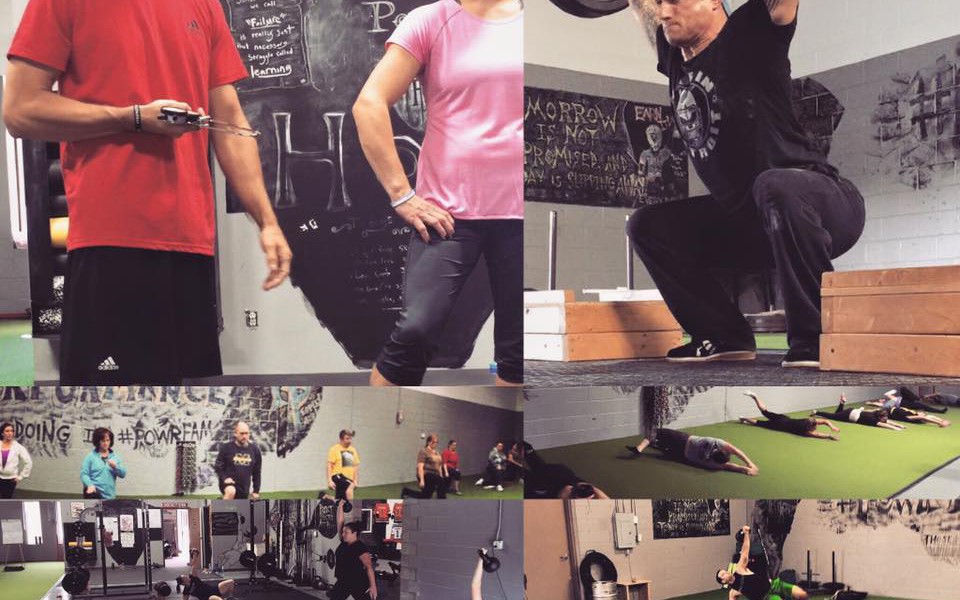
Mind of a Coach: The Dr. is in
The Press: Tell me a little about yourself, who is Dr RJ Burr?
RJ Burr: Well, I live in Plymouth with my wife, Liz, and baby boy, Charlie. I grew up and have lived in Metro Detroit for most of my life (Chicago for chiropractic school). I’ve been involved in CrossFit for almost 2 years. Outside of CrossFit, I enjoy partaking in myriad activities: sports, the outdoors, events and social gatherings. I know it sounds basic, but when it comes down to it I really just love to do “stuff”. At this particular moment I’m really in to fermenting foods, paleo-style cooking, household projects, mountain biking, Oly lifting, craft brews, “yacht rock, “Fargo,” and just being a dad.
TP: OK, so that clears up the “RJ Burr” part, tell me more about the “Dr” part.
RJ: I am a licensed chiropractor with a background in human movement, biomechanics and rehabilitation. That means analyzing how well (or poorly) someone moves, then offering corrective strategies. If you have water damage to the drywall ceiling in your house you would likely replace the drywall, but what if it happened again? Maybe it was actually a leaky pipe or roof that was causing the drywall ceiling to become damaged. This is similar to how I look at the body – identifying the true cause of the problem, not just treating symptoms. If someone comes to see me with knee pain, I don’t just treat the knee; I look at other parts of the body that may be contributing to the cause of the knee pain.
CrossFit consists of many complex compound movements that are quite athletically demanding, requiring the every part of the body to contribute. A physical limitation such as poor ankle mobility often leads to aches, pains, injuries, and even a loss of power in compound movements, especially when loaded (barbell in hands). If you lack stability and/or mobility somewhere in the kinetic chain, it has to be compensated for somewhere else in the body. The problem is that this compensation will overload particular muscles/joints leading to pain and/or injury. My job is to help alleviate pain and optimize function so that you have the ability to move your body the way you and the coaches would like. Improving your numbers while decreasing the risk for injury. These same principles apply to all sports, not just CrossFit.
TP: Couldn’t agree more. How does this philosophy translate to your physical practice?
RJ: I don’t want to get too heavy into the semantics of all the methods I use (If you are, visit omnikinetics.com), but I will say that I use a variety of therapies to help individuals with their joint and muscle pain without the use of drugs, surgery, or relying upon expensive equipment. You won’t step into my office just to get “cracked,” walking out a few minutes later. There is a reason your pain occurred in the first place and it is my job to identify the cause then cultivate a plan of treatment therapies and corrective strategies to help get you from pain to performance, so you can get back to what you love doing most. Not in pain? I still assist with maintenance and recovery strategies for tight muscles and locked joints. I am full-body certified in Active Release Techniques (ART) ¾ considered the gold standard in soft-tissue therapy ¾ which is a hands-on technique that targets to release those tight, problematic areas you cannot seem to get with a foam roll or lacrosse ball. Once released, how do you address the revolving door effect of it coming back? That’s where the application of effective mobility & stability drills come into play, custom-tailored to address the cause of why you may be dealing with muscle imbalance(s).
This active care approach is on the forefront of conservative musculoskeletal therapy (i.e. PT, chiropractic, athletic training) because you achieve quicker, lasting results. You won’t be sold on three visits per week for three months…Those of you that have experience with traditional chiropractic and physical therapy know what I’m talking about!
TP: So where does the Tribe come in?
RJ: In addition to the services mentioned above, I can help coaches integrate effective warm-up, mobility and movement strategies that will improve performance and reduce the risk of injury. Have a question or want to talk shop? Feel free to stop me as I’d love to get to know you! I have no problem spending a moment to do a quick screen, assessment and offer up some advice. If all you needed was a quick fix – great! If you happen to suffer from a nagging ache/pain that does not seem to subside or an old injury that has not fully recovered, I am available just about all day on Tuesdays at the box, where we can set up a consultation to determine if we can get you back to performing your best.
TP: Great! Last question, what’s your most/least favorite Benchmark WOD?
RJ:
Favorite: “Chelsea”
I’m not a “for time” guy, an advocate for controlled bodyweight movements and enjoy the variability of how to approach each interval in regard to intensity and rest time.
Least: “Karen”
For me, doing one movement over and over, much less throwing a ball at an overhead target 150 times, is the equivalent of running a 5K … and I hate long-distance running.
